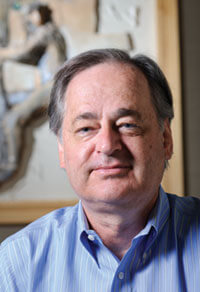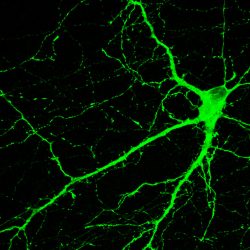Jon Levine
Work flows from “the best of reasons,” says new director of primate research center.
Administering a big research center at the forefront of biomedical science is challenge enough. Running one with 1,500 monkeys is the test of a lifetime. But that is exactly the matchup for Jon Levine, the Northwestern University neuroscientist recruited to UW–Madison in late 2010 to run the Wisconsin National Primate Research Center (WNPRC). For Levine, leading one of the nation’s eight national primate centers is an opportunity to promote the kind of science that led to human embryonic stem cells and remains our best hope for beating diseases such as Parkinson’s and AIDS. At the same time, the center is a magnet for controversy, as the use of monkeys in biomedical research is contentious.
Q: Many people hear about the Primate Center only when there is an issue — or a perceived issue. If there is one thing people should know about the center, what would that be?
A: That researchers and staff are passionate about their work, and that they are wonderful, caring people committed to advancing the cause of human and animal health. The average person knows very well the suffering a family member or friend may endure in disease or injury; unfortunately, few are aware of the importance of biomedical research with non-human primates in developing therapies and strategies for preventing these conditions. I want everyone to know why we do what we do — because we are deeply committed to bringing about a future in which HIV can be prevented, the ravages of Parkinson’s disease can be stalled or reversed, and infertility, complications of pregnancy, and metabolic diseases such as diabetes can be successfully treated.
Q: What do you tell someone — a child, for example — who asks you about the use of monkeys for biomedical research?
A: That we are the good guys. We play by the strictest of rules, intended to ensure the humane and careful utilization of a precious resource. And we have the best of reasons for the work we do. I do not hesitate to give children an explanation in terms they can appreciate. For example, many kids know someone who has been diagnosed with some form of leukemia. We are developing methods to take blood cells from cancer patients and reprogram them into “induced pluripotent stem cells” — make them younger versions of themselves, before they became cancerous. Those induced cells can lead us to an understanding of how blood cells become cancer cells and how we might better treat leukemia.
Q: What do you think we can look forward to in the way of scientific advances from the center in the next few years?
A: I could fill pages with advances I hope will be realized. I’ll mention one that I think could enable progress in many others: transgenesis. The ability to induce, block, or alter the expression of specific genes in the mouse is now routine and has made it the standard for most studies of the genetic mechanisms underlying human disease. However, there are many aspects of human physiology and disease that can only be faithfully reproduced in non-human primates. We are undertaking new approaches to manipulate gene expression in non-human primates. We hope to target genes involved in neurodegenerative diseases such as Parkinson’s, metabolic diseases such as type 2 diabetes, and developmental disorders such as autism.
Q: What will be the greatest challenge for the Wisconsin National Primate Research Center over the next decade?
A: The major challenge for federally funded research institutions is to sustain funding from the National Institutes of Health (NIH) and other sources, especially through times of austerity, flat budgets, and increasing costs. I’m confident, however, that the talented researchers and staff at the WNPRC will keep us positioned to renew our base grant funding from the NIH. I am also certain that researchers who use non-human primates on campus will continue to successfully compete for individual research funding. Nevertheless, given the special costs of research with monkeys, and the preciousness of the resource, we will be looking at new sources of support. Over the longer term, the center’s biggest challenge will be to replace and/or renovate portions of our infrastructure. My vision for a new WNPRC building complex may have to wait until the economy recovers over the next few years — but it is a goal that I hope we can realize.
Published in the Fall 2011 issue



Comments
Rick Bogle August 31, 2011
The Wisconsin Primate Center has been fully functional since 1964. In spite of this forty-seven year history, Mr. Levine relies on wild promises of future benefit rather than past success. He preys on the public’s fears. That’s because real success has been vanishingly rare. He says, “We play by the strictest of rules, intended to ensure the humane and careful utilization of a precious resource.” Unlike new-comer Levine, many of us remember the eight years of the primate center’s broken written promises that monkeys at the Vilas Zoo wouldn’t be used in harmful experiments, and the insider leak demonstrating conclusively that they had never honored their written pledges and had secretly killed and sold to other labs over 200 protected monkeys. Many of the people involved are still there today. He must not know about the precious resources — fifteen years of videotaped research that the primate center literally shredded to keep the public from seeing a single tape. Now we get even more propaganda from the new director. The good guys? Not hardly.
Paula Weinstein September 4, 2011
The canard Levine is peddling about using non-human primate for experiments has been challenged many times. What is the “humane” way of shooting these animals with lethal doses of HIV (which never worked) or any other disease. It is time we emerge from the dark ages with respect to these animals.Or …let the scientists experiment on eachother.
Catherine Goodwin February 2, 2022
I, for one, have no idea how these lab supervisors and technicians sleep at night. When i called a few years ago to give voice to my horror and was ASSURED by the lady in the lab that they treated their primates with the utmost respect and humane treatment, i suggested (if that’s true) then sign your grandchildren up for the next experiments…since primates are a different species rendering most testing on them either inconclusive or void. She hung up. Thank you Paula Weinstein for agreeing with me!
Peter Wood May 5, 2022
This is nothing more than vivisector propaganda. Look at all of their documented animal welfare violations here: https://www.peta.org/features/inside-primate-laboratories/wisconsin-national-primate-research-center/
Peter November 17, 2022
It’s hard to believe that, in 2022, the University of Wisconsin still promotes experimentation on nonhuman primates. It’d be interesting to see how many people chose to look elsewhere for college because of the experiments that continue at the school. I’m certainly one of those people.